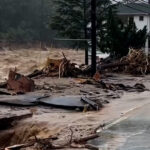Sedimentary rocks, like sandstone or limestone, are formed from the accumulation and cementation of sediments and rockscapes.net offers a comprehensive exploration into the diverse world of sedimentary formations and their applications in landscaping and design. Discover the beauty and utility of these natural stones, learn about sedimentary rock formation, and find inspiration for your next outdoor project.
1. What Defines a Sedimentary Rock?
Sedimentary rocks are types of rock that are formed by the accumulation or deposition of small particles and subsequent cementation of mineral or organic particles on the floor of oceans or other bodies of water at the Earth’s surface. Sedimentation is the collective name for processes that cause these particles to settle in place. Sedimentary rocks cover 70–80% of the Earth’s land surface. They are created by processes such as wind, water, ice, and gravity, which transport and deposit sediments.
Sedimentary rocks provide valuable insights into Earth’s history, as they often contain fossils and evidence of past environments. The study of sedimentary rocks helps geologists understand changes in climate, sea level, and tectonic activity over millions of years. The layering, or stratification, characteristic of sedimentary rocks is a key feature that distinguishes them from other rock types.
2. What Are the Key Processes in Sedimentary Rock Formation?
The formation of sedimentary rocks involves several key processes:
- Weathering: The breakdown of pre-existing rocks into smaller particles through physical and chemical means.
- Erosion: The transportation of weathered material by agents such as water, wind, and ice.
- Deposition: The settling of transported sediments in a basin or depression.
- Compaction: The process by which the weight of overlying sediments reduces the pore space between particles.
- Cementation: The precipitation of minerals within the pore spaces, binding the sediment particles together to form solid rock.
